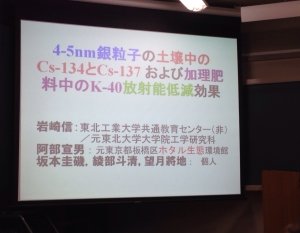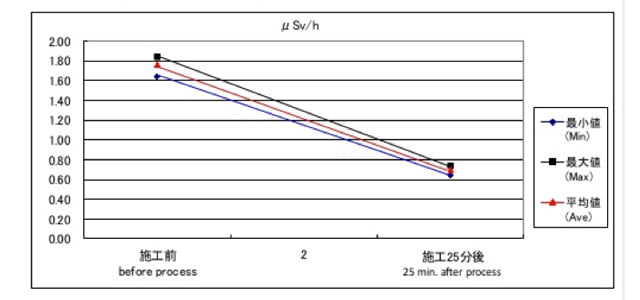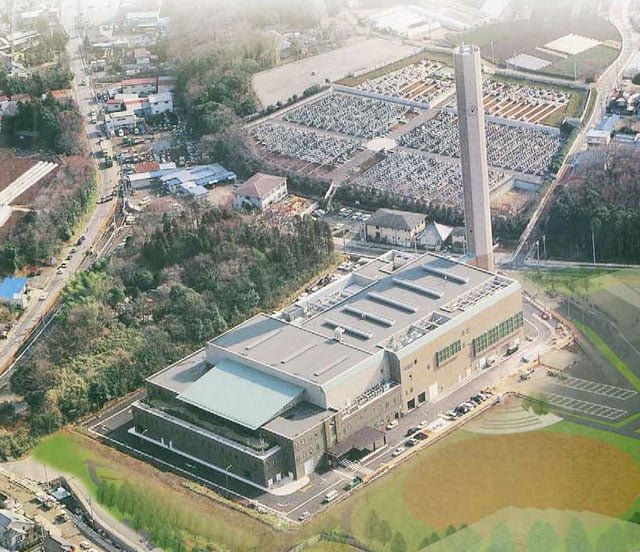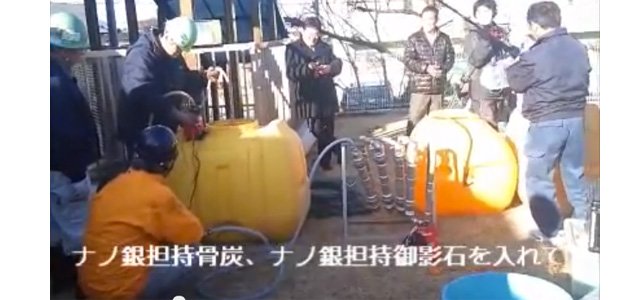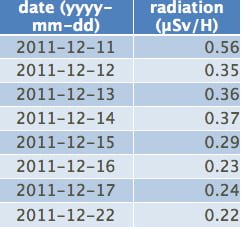The Japan Radioisotope Association (JRIA) held its the 51th workshop of isotope and radiation researh at the University of Tokyo from July 7 to July 9. The program in Japanese is published here.

Dr. Norio Abe and Dr. Shin Iwasaki made presentations about the experiments of radioactivity decreasing effect of 4-5 nm silver particles. The below is quoted from the program and translated to English by me.
Oral Presentation: July 7 (Mon) 10:00 to 11:00 radiation effect
Chair: Masakazu Washio (Waseda University)
Radioactivity Decreasing Effect of 4-5 nm Silver Particles on Cs134 and Cs137 in Soil, and K40 in Potassium Fertilizer
IWASAKI, Shin (Center of General Education, Tohoku Institute of Technology)
ABE, Norio (a former staff of Japan Firefly Breeding Institute, Itabashi-ku, Tokyo)
SAKAMOTO,Kei; AYABE, Tokiyo; MOCHIZUKI, ShojiPoster Presentation: July 7 (Mon) 11:30 – July 8 (Tue) 11:00
Early Experimentation Results of Radioactivity Decreasing Effect of 4-5 nm Silver Particles on Cs134 and Cs in Soil
ABE, Norio; SAKAMOTO, Kei; AYABE, Tokiyo; MOCHIZUKI, Shoji; IWASAKI, Shin
The oral presentation (in Japanese) was recorded by my friend and published the below url. Dr. Iwasaki said he thought the phenomenon might be a kind of LENR at about 11:47 of the video.
http://twitcasting.tv/shivaammachi/movie/77979733
I report the most interesting experiment result in the above presentations in this article.
Dr. Abe and Dr. Iwasaki had been announced the experimental results that the radiation of the contaminated soil was reduced when they added nano sliver solutions to the soil. This presentation showed the new experiment that nano silver particles could decrease radiation of radioactive potassium (K40).
I think this result is very important in the following points.
- Radioactivity decreasing effect of 4-5 nm silver particles was effective for K40 other than radioactive Cs. I think they expected the effect because they have found radioactivity decreasing effect for both Cs137 and Cs134.
- Potassium fertilizer used in the experiment can be purchased by anyone. The key material, 4-5 nm silver particles, is shipped by UFS-REFINE company. Therefore, I expect reproduction of the experiment will become much easier.
(If anyone wants to
My summary of presentation material for the oral presentation by Dr. Iwasaki is shown below.
- K40 is radioactive material present in nature, 0.01% abundance ratio, T1/2 = 12 billion years.
- Because the sensitivity of spectrometer (Clear Pulse Co., A2702) is low, a large amount of potassium fertilizer is required, then they filled U9 type standard container with Potassium fertilizer (76.7g).
- As the first position (“up” position), they put the spectrometer horizontally at the bottom of the lead shielding box and put the U9 container on the spectrometer. As the second position (“down” position), they put the U9 container horizontally at the bottom of the lead shielding box and put the spectrometer on the U9 container. They regarded two measurements, up and down positions (each measurement takes 12 hours), as one unit and calculate the average of result values.
- They started Series I experiment from February 12, 2013. After the initial measurement, they opened the container to check the content, and transferred the content to the tray. Then, they added 5 g of Talc powder supporting nano silver particles (300 ppm) to the content and stirred it. And they added 10 cc of collagen solution supporting nano silver particles (160 ppm) to the content and stirred it carefully. After the process, they returned the content in the U9 container and sealed the joint part of the lid by tape. They did 8 units of measurements until August 9. For the measurements, they also measured background radiation many times.
(They watered UFS-CW20F to get suitable density (160 ppm) as collagen solution supporting nano silver particles.) - Because in the 8 units of measurements, they missed the down position measurements in 2 times, they showed the 6 units results. Each figure shows relative ratio to the initial radiation value. Each radiation value is calculated as
[total number of photoelectric peak area of K40] – [background].
Feb 13 up, Feb 14 down (initial value): 1.00
Feb 15 up, Feb 16 down: 0.83
Feb 17 up, Feb 18 down: 0.87
Apr 8 up, Apr 9 down: 0.81
May 5 up, May 6 down: 0.79
Jun 27 up, Jun 27 down: 0.80
Jul 24 up, Jul 25 down: 0.77
Aug 9 up, Aug 9 down: 0.80
- As the result, the decreasing ratio is about 20%. The estimated uncertainty of the average value taking into account the “up / down” difference is about 3% to 12% and the statistical uncertainty is under 2.5%.
- On September 10, they opened the U9 container to check the content and injected 5cc of collagen solution supporting nano silver particles (20ppm) to the center of the content. From one day later, they started Series II measurements and they are going now. They obtain the similar result in the Series II.
- In conclusion, they can set the hypothesis that 4-5 nm silver particles can decrease the radioactivity of K40, too.
I expect that other scientists will reproduce the experiment and find new technology to reduce radioactivity of huge volume of nuclear waste.
Cold Fusion Now!


